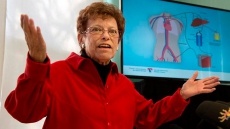VANCOUVER — The federal government approved the environmental assessment application on Friday for the massive KSM gold and copper mine in northwestern British Columbia near the Alaska border.
The mine, which is owned by Seabridge Gold Inc. (TSX:SEA), is considered the largest undeveloped gold reserve in the world and also has copper, silver and molybdenum deposits.
The project would be just 35 kilometres from the Alaska border, and in August the state took the rare step of asking the Canadian government for involvement in the approval process over concerns for its rivers and fish.
But the Canadian Environmental Assessment Agency concluded in its report that the KSM project isn't likely to cause significant adverse environmental effects.
Seabridge CEO Rudi Fronk said the company was confident it would receive the approval because it has spent six years and $200 million working with government, local First Nations and the state of Alaska.
The company conducted 40 working group sessions with federal and provincial regulators, First Nations and American regulators, he said.
"From our perspective, the environmental assessment process in Canada works. However, it takes a very long time and is very expensive," he said. "But if you get proper engagement with the regulators and with the First Nations and treaty nations, you can successfully get projects approved."
Fronk said that meant a lot of listening and design changes where appropriate.
"We probably made a number of design changes over the years that amounted to about $500 million of additional capital that's going into the project as a result of those design changes."
Seabridge initiated the process in March 2008.
Fronk said the company has letters of support from all the groups they're dealing with, including First Nations.
The mine is on the territory of the Nisga'a Nation, and Seabridge reached agreement earlier this year with the Nisga'a that includes financial payments, profit sharing and commitments to employ band members.
There is also an agreement with the nearby Gitanyow First Nation and they are currently in the Tahltan Nation, Fronk said.
Environmentalists, aboriginal groups and commercial fishermen in Alaska claim the project poses a risk to rivers that flow into their state, and they've pointed to a recent tailings spill at an unrelated mine in central B.C. to amplify those worries.
But Fronk said he believed the process answered the concerns voiced from the state.
The project would be located near the Unuk River system that flows into Alaska. The mine's tailings facility would be in the Naas River watershed, which empties into the Pacific Ocean off B.C.
Carrie James, tribal council treasurer of the Ketchikan Indian Community in Alaska said she's extremely disappointed by the decision.
"The Canadian government has disregarded our concerns about how KSM could pollute our waters and destroy our salmon fisheries and jobs. Salmon and clean water underpin our culture, economy and way of life," she said in a news release.
Seabridge has yet to find a mining company that will build the project. Fronk said his company doesn't have the finances or the technical expertise to build a mine of that size.
"This is a project that's going to take over $5 billion to build. It's a very large project and it really requires the input and the expertise that comes from the major mining companies that have built mines like this before."
He said the firm is in negotiations with several of the world's larger mine companies.





